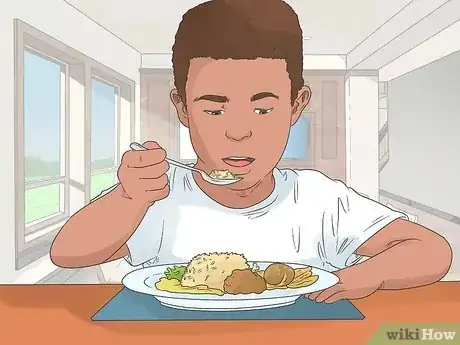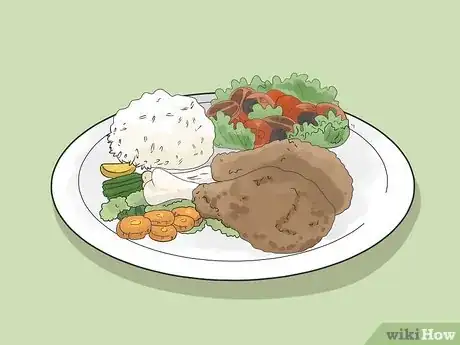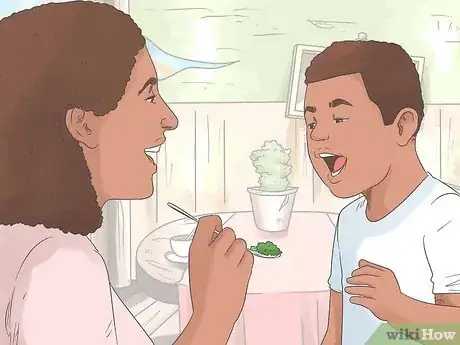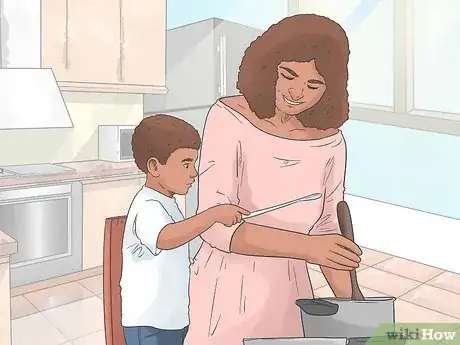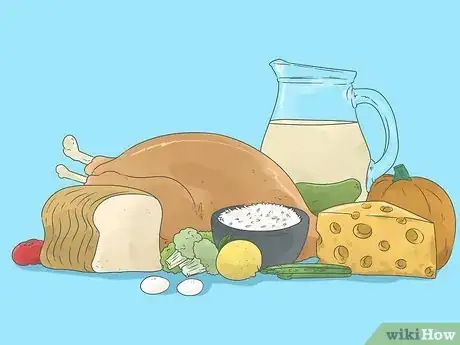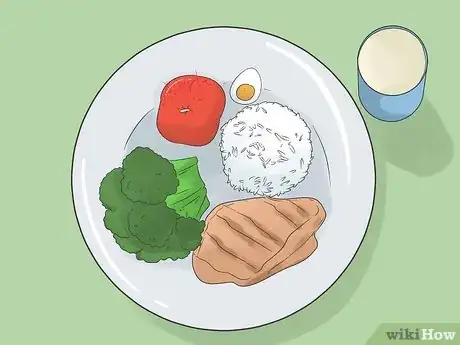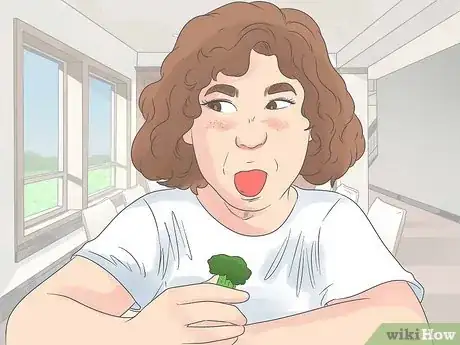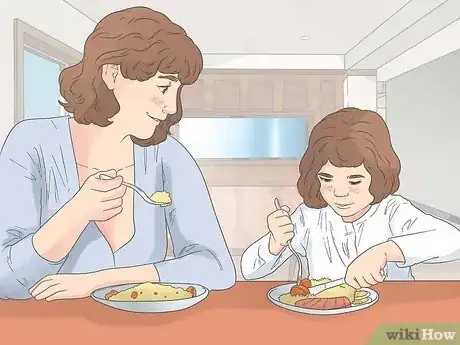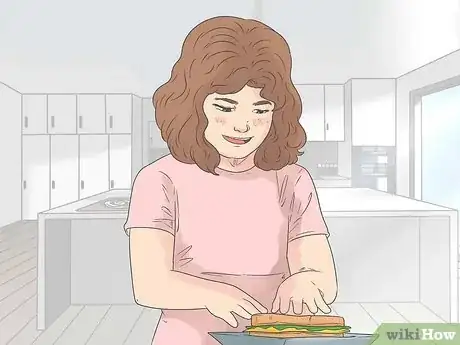This article was co-authored by Amy Chow. Amy Chow is a Registered Dietitian and the Founder of Chow Down Nutrition, a family and child nutrition consulting service in British Columbia (BC), Canada. With over nine years of experience, Amy has a special interest in pediatric nutrition, food allergy management, and eating disorder recovery. Amy holds a Bachelor’s degree in Nutritional Sciences from McGill University. She gained her clinical experiences at residential and outpatient eating disorder treatment programs as well as for BC Children’s Hospital before starting her own business. She has been featured on Find BC Dietitians, Dietitians of Canada, Food Allergy Canada, Recovery Care Collective, Parentology, Save on Foods, National Eating Disorder Information Centre (NEDIC), and Joytv.
There are 18 references cited in this article, which can be found at the bottom of the page.
This article has been viewed 67,073 times.
Most parents have likely battled with their kids about eating foods they don't like to eat.[1] Refusing to eat certain foods is a way for children to express their independence and test boundaries.[2] It's also important to understand that most children are picky eaters and their palates will change as they age.[3] By managing meals, keeping the environment positive, and understanding children's dietary preferences and needs, you can get your kids to eat foods they don't like.[4]
Steps
Managing Meals
-
1Consider your children's tastes. When you're cooking, don't necessarily make meals geared towards your kids. However, consider their tastes in addition to yours when planning and cooking meals.[5]
- Make a couple of offerings you know your kids will like if you're trying a new recipe.[6] For example, if you're making meatloaf for the first time, consider having sides you know your kids will eat such as potatoes, pasta, or cut veggies.[7]
- Remember that you're not a short order cook, but you can tailor dishes you are already making. For example, if you're putting a spicier topping on your meatloaf, consider leaving part of it plain for the kids. Allow them to try the spicy part if they like.[8]
-
2Keep reintroducing foods. Children are often slow to accept new tastes and textures in food.[9] Encourage your child to try the foods by continuing to place a small portion on their plate.[10] You may find that your child eventually tries—and likes—the food.[11]Advertisement
-
3Incorporate liked and disliked foods into 1 dish. Vegetables, certain cheeses, or spices are often foods that kids don't like.[14] Mixing foods that kids don't like with dishes they do like can not only get them to eat the food, but also like it.[15]
- Keep the mixing simple. For example, if your kids don't like peas, add them to some rice with a little sauce. For zucchini, you could replace a few lasagna noodles with zucchini strips.[16]
- Reveal what's in the dish only when your child says how much they likes it. Remember to stay positive. For example, “I'm so glad you like the lasagna! And you know what else, it has zucchini in it with the noodles. They give it a little extra special taste.”
- Remind your child that they've tried the dish before and liked it.
-
4Ask them to try 1 bite—and no more. Many experts agree that negotiating or bribing your child to eat foods they don't like just doesn't work.[17] If there is a food they “think” they don't like, ask them to try 1 bite of it without forcing them.[18]
- Allow your child to try or leave the food on the plate and don't force them.[19] They may end up trying the food once they see other people eating it.[20]
- Avoid negotiating with your child.[21] Saying things like “a little bit for Dad” or “1 more bite for Mom” are not normal eating behaviors.[22]
- Try avoiding bribery as well. There is no unanimous consensus on bribing your child to eat with promises of food they like, but most experts agree that it is not an advisable practice.[23]
-
5Put disliked foods on the table first. Many children play before dinnertime and generate a healthy hunger during this time. If you're serving a food, such as a vegetable side dish, that your child doesn't like, consider putting it on the table before anything else. Their hunger may get the better of their aversion.[24]
- Tell your child you're getting the main dish ready and it's going to be a few minutes. Point out that there is something already on the table and that they can start with that.
- Remember not to force your child to eat food, which is often ineffective and counterproductive.[25] If they're hungry enough, they'll likely eat it.[26]
-
6Cook together. Get your kids involved with meal preparation. This gives them the chance to see and feel the ingredients and different foods, including foods they may not like. It may also make them want to try the dish they helped make, even if it contains something they think they don't like.[27]
- Allow your child to take active part in cooking through chopping, stirring, bringing plated food to the table, or setting the table.
- Make sure to praise your child at dinner for their help. For example, “Sophie, you did such a great job cooking tonight. Everyone, doesn't this taste amazing?”
-
7Eat as a family unit. Studies have shown that children eat a more nutritious diet when they have regular family meals.[28] As often as possible, set a place for every family member, including your child, at the dinner table and eat as a family unit.[29]
- Eat together even if everyone isn't home. Make sure to explain this to your child. For example, “Mom had a meeting tonight and wanted to be here with us, especially since we're having this awesome lasagna.”[30]
- Create positive peer pressure during the meal. If your child sees others eating and enjoying food they don't like, they may be more inclined to try those foods.[31] Model good behavior for your child by eating and enjoying the same healthy foods that you want your child to eat.[32]
Recognizing Children's Tastes and Dietary Needs
-
1Take a broad approach to nutrition. The American Academy of Pediatrics (AAP) recommends that parents focus on the child's whole eating pattern rather than on pinpointing specific things for the child to avoid.[33] You can help ensure your child is getting what they need by:[34]
- Selecting nutritious foods from the 5 food groups: vegetables, fruits, grains, low-fat dairy, and quality protein sources like lean meats and eggs.
- Giving children a variety of food experiences.
- Staying away from highly processed foods.
- Using small amounts of sugar, salt, and fats with high nutrition choices to enhance the child's enjoyment of the food.[35]
-
2Give appropriate portions sizes. People often overestimate how much food they need and this is no different with what they give their children.[36] Offering your child only as much food as they can eat may help her consume choices they don't like.[37]
- Check the suggested portion size for your child's age before serving food.[38] For example, there is a big difference between what a 1 year old should get and what their 5 year old brother or sister should eat. A 1 year old can have ¼ cup cooked vegetables, where a 5 year old can have a ¼ cooked vegetables with ½ cup salad.[39]
- Keep the portions on the smaller size, which may be less overwhelming for your child.[40] Smaller portions also discourage overeating, though you can always give your child more food if they are hungry.[41]
- Be aware that many children don't eat enough at mealtimes to keep themselves full. Aim to give your child 3 meals and 2 snacks every day.[42] Make sure the snacks are high quality nutrition such as string cheese, yogurt cups, apple slices, a piece of lean turkey, or whole grain crackers with peanut butter.[43]
- Space out mealtimes and snacks as evenly as possible. Offer snacks well in advance of meals. This can ensure that your child eats a full meal.[44]
-
3Recognize children's sensitive palates. Recent research has shown that children have different taste palates than adults, in many cases preferring sweet foods to savory or salty options.[45] Keep in mind that children's tastes are different than an adult's tastes. Their tastes may change as they age. You might find it easier to prepare meals for your child if you are aware of their food aversions.[46]
- Be aware that a child's love of sugar may come from the fact that sugar can be a natural pain reliever in children, as recent research has shown.[47] However, this doesn't mean that you should indulge all of your child's sugar cravings.[48]
- Realize that your child's tastes may change overnight.[49]
- Consider avoiding very spicy foods and snacks. Many children may find the flavor too much to handle, but recent studies have also shown they can cause inflammation to the stomach lining as well as abdominal pain.[50]
- Be aware that recent studies show that children have larger reactions to unpleasant smelling foods like pungent cheeses.[51] Allow them to feel out if they want to try “smelly” foods.
-
4Have a routine. Children often thrive with routines, and having regular mealtimes with the same seating arrangement may help your child be more adventurous with food.[52] Make sure to engage everyone at the table, including your child, in conversation to keep things fun and interesting.[53]
- Ask your child what her favorite part of the meal is and what she learned at school that day.
- Keep the tone of your conversations pleasant. This can help your child look forward to mealtimes and may make her more receptive to new foods.[54]
- Give your child a chance to settle down before eating if they're playing. Tell your child 10 to 15 minutes before dinner starts so they can get themselves ready.[55]
-
5Manage your expectations. Fussy eating is often not a child's problem, but 1 of the parent.[56] Keeping your own expectations for your child's eating habits in check—while making sure they're getting proper nutrition—may help prevent battles over food.[57]
- Remember that children often won't like the idea of something new on their plate.[58] Keep reintroducing the food until the child is used to it.
- Let your child be a child and remember that change can be difficult for them.[59]
- Leave your child alone and don't force them to eat.[60] Studies have shown that forcing a child to eat is counterproductive.[61]
- Be aware that your child won't starve if they don't eat. In fact, they are more likely to learn to be more flexible in their choices than they are to go hungry.[62]
- Avoid enforcing unrealistic manners. For example, a spoon is often easier for a child to handle than a fork.[63]
References
- ↑ http://kidshealth.org/parent/nutrition_center/healthy_eating/toddler_meals.html
- ↑ http://kidshealth.org/parent/nutrition_center/healthy_eating/toddler_meals.html
- ↑ http://familydoctor.org/familydoctor/en/kids/eating-nutrition/healthy-eating/when-your-toddler-doesnt-want-to-eat.html
- ↑ http://kidshealth.org/parent/nutrition_center/healthy_eating/toddler_meals.html
- ↑ http://www.parenting.com/article/7-ways-to-end-picky-eating
- ↑ http://www.parenting.com/article/7-ways-to-end-picky-eating
- ↑ Amy Chow. Pediatric Dietitian. Expert Interview. 16 September 2020.
- ↑ http://www.parenting.com/article/7-ways-to-end-picky-eating
- ↑ http://kidshealth.org/parent/nutrition_center/healthy_eating/toddler_meals.html
- ↑ Amy Chow. Pediatric Dietitian. Expert Interview. 16 September 2020.
- ↑ http://kidshealth.org/parent/nutrition_center/healthy_eating/toddler_meals.html
- ↑ http://kidshealth.org/parent/nutrition_center/healthy_eating/toddler_meals.html
- ↑ http://kidshealth.org/parent/nutrition_center/healthy_eating/toddler_meals.html#
- ↑ http://www.parenting.com/article/7-ways-to-end-picky-eating
- ↑ http://www.parenting.com/article/7-ways-to-end-picky-eating
- ↑ http://www.parenting.com/article/7-ways-to-end-picky-eating
- ↑ http://familydoctor.org/familydoctor/en/kids/eating-nutrition/healthy-eating/when-your-toddler-doesnt-want-to-eat.html
- ↑ http://kidshealth.org/parent/nutrition_center/healthy_eating/toddler_meals.html#
- ↑ http://www.bbcgoodfood.com/howto/guide/carlos-gonzalos-my-child-wont-eat
- ↑ http://kidshealth.org/parent/nutrition_center/healthy_eating/toddler_meals.html#
- ↑ http://kidshealth.org/parent/nutrition_center/healthy_eating/toddler_meals.html#
- ↑ http://www.bbcgoodfood.com/howto/guide/carlos-gonzalos-my-child-wont-eat
- ↑ http://kidshealth.org/parent/nutrition_center/healthy_eating/toddler_meals.html#
- ↑ http://www.parenting.com/article/7-ways-to-end-picky-eating
- ↑ http://www.bbcgoodfood.com/howto/guide/carlos-gonzalos-my-child-wont-eat
- ↑ http://kidshealth.org/parent/nutrition_center/healthy_eating/toddler_meals.html#
- ↑ Amy Chow. Pediatric Dietitian. Expert Interview. 16 September 2020.
- ↑ http://kidshealth.org/parent/nutrition_center/healthy_eating/toddler_meals.html#
- ↑ Amy Chow. Pediatric Dietitian. Expert Interview. 16 September 2020.
- ↑ http://kidshealth.org/parent/nutrition_center/healthy_eating/toddler_meals.html#
- ↑ http://kidshealth.org/parent/nutrition_center/healthy_eating/toddler_meals.html
- ↑ http://www.healthyeating.org/Healthy-Kids/Eat-Play-Love/Article-Viewer/Article/271/healthy-eating-starts-with-parent-role-models.aspx
- ↑ https://www.aap.org/en-us/about-the-aap/aap-press-room/pages/AAP-Recommends-Whole-Diet-Approach-to-Children's-Nutrition.aspx
- ↑ Amy Chow. Pediatric Dietitian. Expert Interview. 16 September 2020.
- ↑ https://www.aap.org/en-us/about-the-aap/aap-press-room/pages/AAP-Recommends-Whole-Diet-Approach-to-Children's-Nutrition.aspx
- ↑ http://kidshealth.org/parent/nutrition_center/healthy_eating/toddler_meals.html#
- ↑ https://www.aap.org/en-us/about-the-aap/aap-press-room/pages/AAP-Recommends-Whole-Diet-Approach-to-Children's-Nutrition.aspx
- ↑ https://www.healthychildren.org/English/healthy-living/nutrition/Pages/Portions-and-Serving-Sizes.aspx
- ↑ https://www.healthychildren.org/English/healthy-living/nutrition/Pages/Portions-and-Serving-Sizes.aspx
- ↑ http://kidshealth.org/parent/nutrition_center/healthy_eating/toddler_meals.html#
- ↑ http://kidshealth.org/parent/nutrition_center/healthy_eating/toddler_meals.html#
- ↑ http://familydoctor.org/familydoctor/en/kids/eating-nutrition/healthy-eating/when-your-toddler-doesnt-want-to-eat.html
- ↑ http://familydoctor.org/familydoctor/en/kids/eating-nutrition/healthy-eating/when-your-toddler-doesnt-want-to-eat.html
- ↑ http://familydoctor.org/familydoctor/en/kids/eating-nutrition/healthy-eating/when-your-toddler-doesnt-want-to-eat.html
- ↑ http://www.npr.org/sections/thesalt/2011/09/26/140753048/kids-sugar-cravings-might-be-biological
- ↑ http://www.npr.org/sections/thesalt/2011/09/26/140753048/kids-sugar-cravings-might-be-biological
- ↑ http://www.npr.org/sections/thesalt/2011/09/26/140753048/kids-sugar-cravings-might-be-biological
- ↑ http://www.npr.org/sections/thesalt/2011/09/26/140753048/kids-sugar-cravings-might-be-biological
- ↑ http://www.bonappetit.com/entertaining-style/trends-news/article/sense-of-taste-changes-aging
- ↑ http://www.foxnews.com/health/2013/11/18/spicy-snack-foods-sending-children-to-emergency-room-experts-claim.html
- ↑ http://www.thedailymeal.com/stop-trying-feed-your-kid-stinky-cheese
- ↑ http://familydoctor.org/familydoctor/en/kids/eating-nutrition/healthy-eating/when-your-toddler-doesnt-want-to-eat.html
- ↑ http://familydoctor.org/familydoctor/en/kids/eating-nutrition/healthy-eating/when-your-toddler-doesnt-want-to-eat.html
- ↑ http://familydoctor.org/familydoctor/en/kids/eating-nutrition/healthy-eating/when-your-toddler-doesnt-want-to-eat.html
- ↑ http://familydoctor.org/familydoctor/en/kids/eating-nutrition/healthy-eating/when-your-toddler-doesnt-want-to-eat.html
- ↑ http://www.bbcgoodfood.com/howto/guide/carlos-gonzalos-my-child-wont-eat
- ↑ http://familydoctor.org/familydoctor/en/kids/eating-nutrition/healthy-eating/when-your-toddler-doesnt-want-to-eat.html
- ↑ http://www.bbcgoodfood.com/howto/guide/carlos-gonzalos-my-child-wont-eat
- ↑ http://www.bbcgoodfood.com/howto/guide/carlos-gonzalos-my-child-wont-eat
- ↑ http://www.bbcgoodfood.com/howto/guide/carlos-gonzalos-my-child-wont-eat
- ↑ http://kidshealth.org/parent/nutrition_center/healthy_eating/toddler_meals.html#
- ↑ http://kidshealth.org/parent/nutrition_center/healthy_eating/toddler_meals.html#
- ↑ http://familydoctor.org/familydoctor/en/kids/eating-nutrition/healthy-eating/when-your-toddler-doesnt-want-to-eat.html
About This Article
One way to get your kids to eat food that they don’t like is by making meals that have many different foods. For example, you can incorporate 2 to 3 foods that they do like into a meal with a disliked food as a side dish. Encourage your child to try 1 bite of the food that they don’t like, and don’t pressure them to eat any more than that. Bribing your child or coercing them might create unhealthy eating habits. You can also get your child involved in dinner by asking them to help you in the kitchen, which can familiarize them with different foods. To learn more from our Dietitian co-author, like how to provide your kids with a healthy portion size of the food, keep reading the article!


